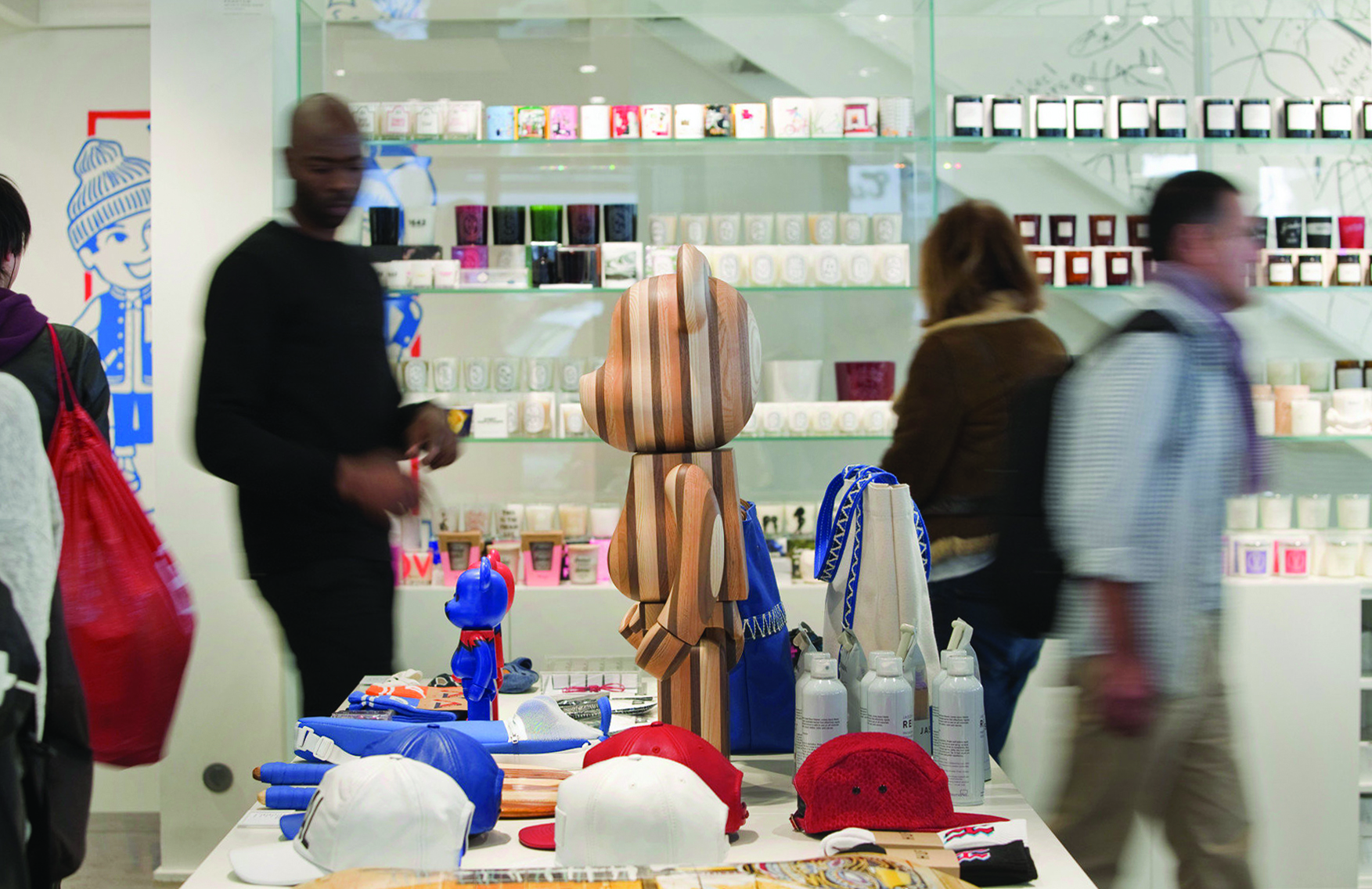The Old Curiosity Shop
by Lauren Elkin

Colette, on the rue Saint-Honoré in Paris. Photo: Edgar Zippel/ERCO.
The Parisian fashion emporium Colette is closing, and it’s the end of an era. One Wednesday morning this past July, a statement appeared on its Instagram account: “As all good things must come to an end, after 20 wonderful years, Colette should be closing its doors on Dec 20 of this year.” Across social media, fashion editors, designers, buyers, and assorted hangers-on sent up a collective wail. Founded by Colette Roussaux and her daughter Sarah Andelman in 1997, and sprawling over three levels and 8,000 square feet, the shop on rue Saint-Honoré introduced a populist maximalism to the mostly austere, conservative fashion boutiques that reigned in Paris. Colette carried heritage labels as well as scrappy up-and-comers upstairs, and streetwear downstairs, along with a range of accessories, art books, gadgets, and quirky knickknacks; it was as if Barneys had merged with Claire’s and The Sharper Image. The shop quickly became a focal point for the kind of 90s cool that also sent fashionistas flocking to the nearby Hôtel Costes, where they dined on Asian fusion appetizers and listened to French Touch electronica. Soon Colette opened a Water Bar in the basement, where you could famously try something like a hundred different kinds of still and sparkling bottled water.
Colette opened a mere two years before I moved to Paris, and over the two decades of its existence, though I’ve accrued what I think is the normal amount of confidence that comes between the ages of almost 20 and almost 40, I’ve remained terrified of the place. The clothes are on mannequins, so you can’t do that comforting thing of briskly sliding clothing hangers along the rack, inspecting textures, details, and, surreptitiously, prices; you have to hang around, vulnerable, exposed, and point to what you want, and ask for it in your size. Not that I could afford anything even if it did fit. The only thing I could buy there is the kind of clutter I have banished from my apartment, lacking the space to accommodate tie-dyed blocks of post-it notes, keychains that read “I believe in tacos,” or plastic trays with blue and purple moose heads on them. If it weren’t all so tongue-in-cheek and adorable, Colette would almost be insulting, given that anything genuinely desirable — a gorgeous Victorian structured lace dress from Zimmermann, the Olympia Le-Tan purses embroidered with book covers — is out of reach for most of the people who walk through its doors. Let them buy trinkets!

In my first Paris years, I kept noticing a particular kind of French store that seemed to thrive on selling tchotchkes: salad servers with manga characters on them, sponge-holders shaped like beagles. Or there were the eccentric local clothing boutiques where the theme of the week would be, for instance, the color purple, and everything they put in the window, sweaters or fingerless gloves or silk scarves or what-have-you, was all in shades of violet and burgundy. (What in America is mall culture is, in Paris, high whimsy.) It strikes me now that Colette is a more upscale version of these shops — and that, in its commitment to selling people cutesy bits of ephemera they don’t need, Colette belongs to the great French tradition of the magasin de nouveautés, or novelty shop. Balzac describes one of them in César Birotteau (1837), part of his Scènes de la vie parisienne series:
Constance Pillerault was the head shop-girl of a fancy store called Le Petit Matelot, the first of those stores which have since been established in Paris, with a greater or less number of painted signs, floating banners, showcases of gracefully suspended shawls, cravats built up like card houses, and a thousand other commercial attractions, fixed prices, scrolls, placards, optical illusions, and special effects carried to such a degree of perfection that shop-fronts have become poems that have taken material shape.
The magasins de nouveautés were often found in the arcades, those covered passages that predated the department store. According to Walter Benjamin they recalled an even older form of business: jumble shops that predated the specialized shop of the early 19th century, the kinds of stores that only sell gloves, or umbrellas, or bolts of fabric. “Here,” the philosopher wrote in The Arcades Project, “in antique bric-à-brac, reemerges the old physiognomy of trade that, in the first decades of the previous century, began to be supplanted by the rule of the spécialité.” These mom-and-pop shops are arguably the original concept stores; Colette even lives upstairs from her shop, and rumor has it she would man the register from time to time, unrecognized by most of her customers. In transforming the magasin de nouveautés into the concept store, Colette took an aesthetic that was already part of the retail landscape in Paris and made it cool. (Well, cool-ish: that orange leather backpack in the shape of a penguin for €2400 is pushing it.)

In Paris the vibe has changed a lot since 1997; “cool” is no longer to be found in the moneyed west of the city, where Colette is located, but in the formerly working-class, now bourgeois-bohemian northeast. Colette was wise to that as well — it recently sold t-shirts that read BELLEVILLE HILLS, which Rihanna was spotted wearing — but the creative class of the 11th and 19th arrondissements rarely traipses over to the swank rue Saint-Honoré. There is some suggestion that the shop will endure online — very 21st century, very new Paris — and no doubt Sarah Andelman’s next brick-and-mortar projects will be as inspiring and off beat as Colette. But it’ll be a shame to see the premises taken over by the likes of Saint Laurent; for that will be a far cry indeed from the magasin de nouveautés, and Paris will be poorer for it.